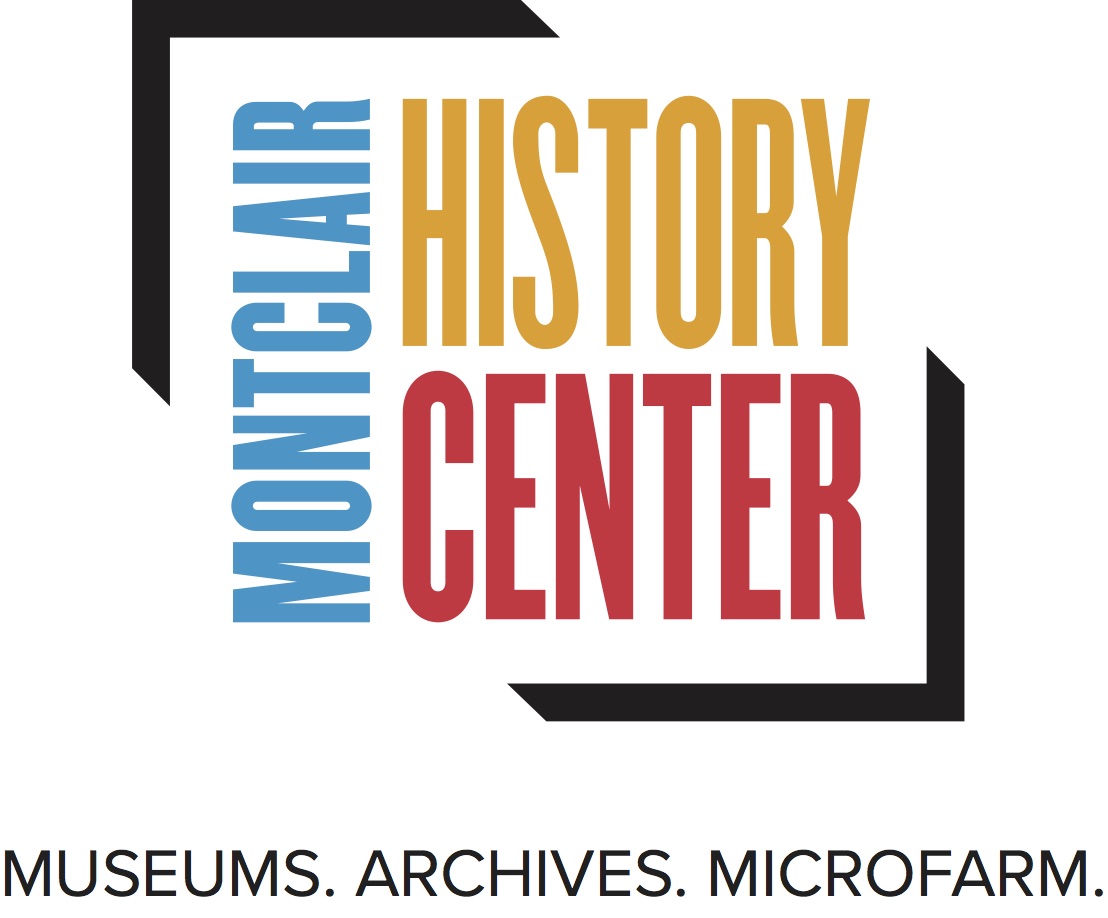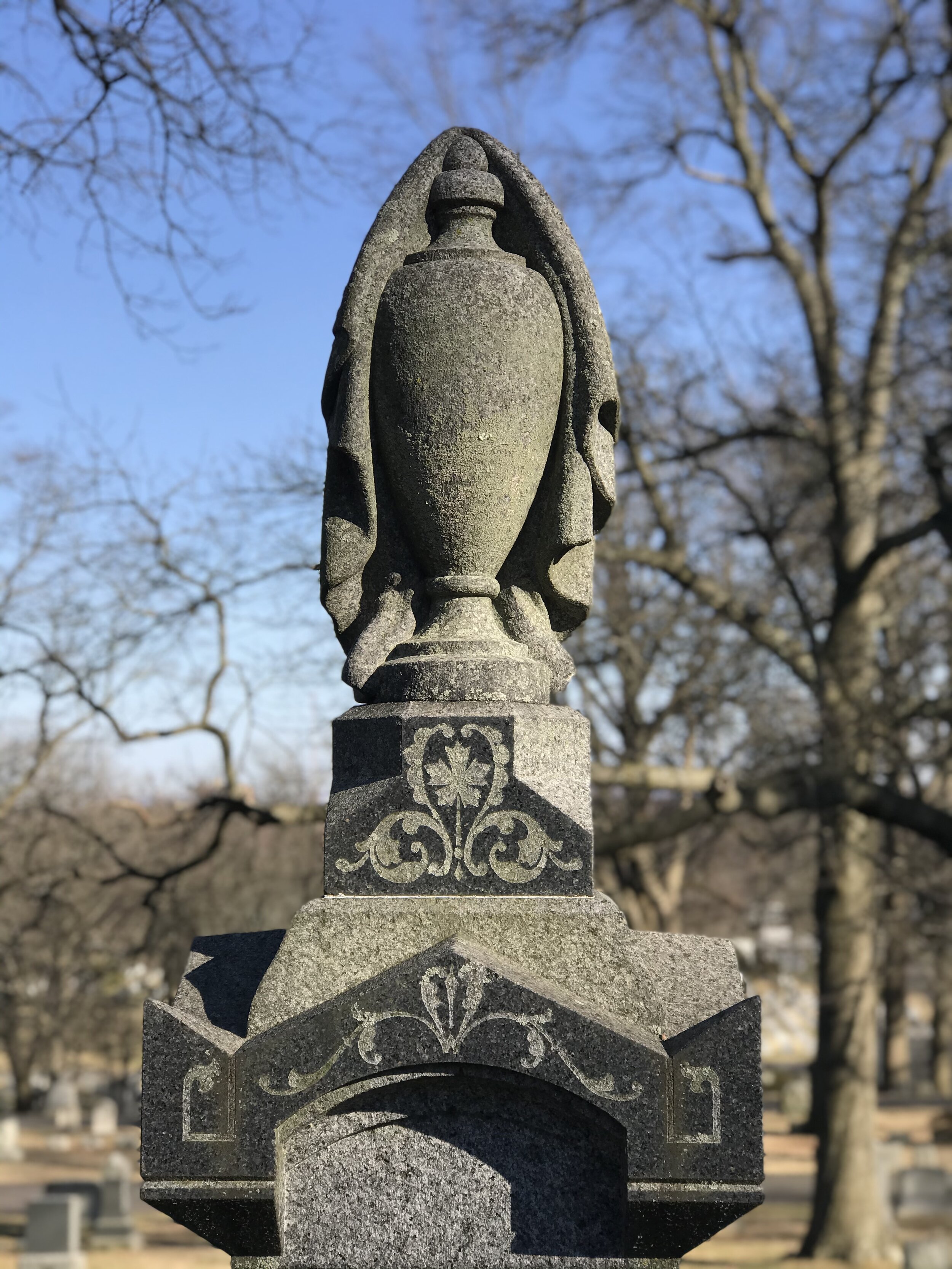Helen Fallon, Trustee, Montclair History Center and Lisanne Renner, Historian, Friends of Anderson Park. Photos are courtesy of Helen Fallon.
Most of us don’t linger in cemeteries, but in the 1800s cemeteries such as Mt. Hebron in Upper Montclair were considered inviting destinations. Come for a stroll or perhaps a picnic. Established in 1863, the Mt. Hebron Cemetery is a beautiful example of the “rural cemetery” or “garden cemetery” movement of the mid-1800s. Cemeteries in this style offered a soothing, sentimental view of death as eternal rest and return to the garden, in contrast to older-style graveyards where winged skulls were carved into tombstones.
This bird bath grave marker reinforces the naturalistic setting of Mt. Hebron Cemetery.
Families of those interred enjoyed cemetery visits for relaxation, remembrance, and even a repast. Tabletop-style tombstones, of which there are several here, could literally function as tables. Mt. Hebron Cemetery, like Mt. Auburn Cemetery in Cambridge, Mass., and Mt. Hope Cemetery in Rochester, NY, is defined by its naturalistic landscape design and picturesque hillside setting, vibrant with spring blooms and fall foliage.
Mt. Hebron Cemetery has no religious affiliation and is not associated with the adjacent church at the corner of Valley Road and Mt. Hebron Road. However, many congregants of that church (known as the Montclair Heights Reformed Church when built in 1901) did end up in the cemetery next door.
Mt. Hebron Cemetery, at 851 Valley Road, began in 1863 on 2.5 acres of Peter G. Speer’s farm. (The Speers were among the founding Dutch families of Upper Montclair, then called Speertown.) The cemetery expanded to 18 acres in 1900 and today it covers 30 acres. It is adjacent to the Immaculate Conception Cemetery, established in the late 1800s, which borders Grove Street and Mt. Hebron Road.
Symbolism
An amble through any cemetery reveals interesting symbolism waiting to be decoded. Some common iconography at Mt. Hebron Cemetery includes: ivy (fidelity); lily (purity); wreath (victory in death); torch (upright, it represents life and inverted, it represents death); wheat (a long life harvested at the appropriate time); a draped urn (represents a protective veil for the soul). The lamb (usually marking a child’s grave) and tree trunk (a life cut short) are especially poignant. Careful observers will also notice some unusual imagery at Mt. Hebron Cemetery that speaks to the particular interests of the deceased, including headstones with train, rocket and bicycle motifs. One large, eye-catching headstone resembles a fireplace (said to be inspired by a French fireplace) made of black onyx with an insert of intricately carved marble and the inscription, “He hunted the lion.”
A draped urn represents a protective veil for the soul.
Montclair Notables
Inventors, politicians, local heroes, architects, artists, local historical figures, and everyday people with plots lovingly maintained by their families populate this “silent city” of nearly 20,000. Some familiar names include:
Herman Hupfeld (1894-1951) wrote “As Time Goes By,” the song in the movie “Casablanca.” Clary Anderson (1911-1988) was a legendary Montclair football and baseball coach. Alice Hooe Foster (c. 1875-1940) was the first female African-American graduate of Montclair High School and founded the Montclair YWCA in 1912. Allen Du Mont (1901-1965) invented the first commercial TV set by perfecting the cathode-ray tube in 1940 and his first lab was on Valley Road. Shirley Booth Baker (1898-1992) has one of the most frequently visited burial sites; she was most famous for her title role in the 1960s sitcom “Hazel.” (She is buried in her husband’s family plot.) Benjamin Moore (1854-1917) – yes, that Benjamin Moore of paint fame –is buried here. Chapin Crawford Barr (1896-1918) was the first U.S. Marine aviator killed in action in World War I. He, like up to 40 percent of the Americans who died in that war, is buried in an American cemetery in Europe. His headstone in Montclair includes a detailed description of his heroism. Aubrey Lewis (1935-2001) was a football great from Montclair High who went on to break barriers at Notre Dame and the F.B.I.
Shirley Booth Baker\ played Hazel in an 1960s sitcom.
Chime Tower
The chime tower occupies a prominent spot and rings twice a day – at 11 a.m. and 2:30 p.m. It was designed by Arthur Ramhurst in 1933, also the architect of notable homes in Montclair, as well as Bradner’s Pharmacy in Watchung Plaza and Shomrei Emunah synagogue on Park Street. Ramhurst was buried here in 1962, within earshot of his chimes.
The Chime Tower rings twice daily.
Origin of Mt. Hebron Name
An article in The Montclair Times from 1892 explains the biblical origins of the cemetery’s name: “Mount Hebron was appropriately named by its founder the late Peter G. Speer, after the passage of scripture which tells of Abraham burying his wife Sarah in Hebron.”
The Montclair History Center, in collaboration with Friends of Anderson Park, occasionally conducts tours/presentations about Mt. Hebron Cemetery. Rosedale Cemetery tours/presentations are also presented. See www.montclairhistory.org.)




